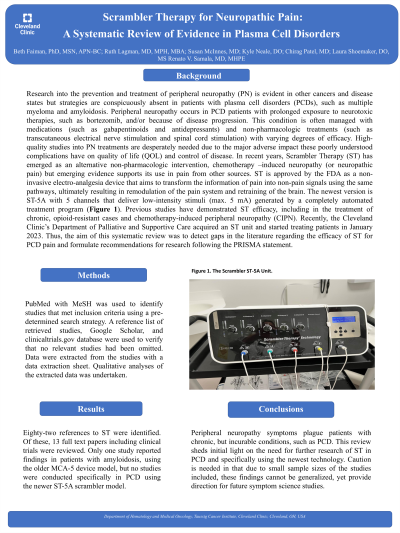Nursing Symposium
Poster Session 1
NSP-06: Scrambler Therapy for Neuropathic Pain: A Systematic Review of Evidence in Plasma Cell Disorders
Wednesday, September 27, 2023
1:30 PM - 2:30 PM EEST


Beth Faiman, PhD, MSN, APN-BC,BMTCN, AOCN, FAAN, FAPO
Nurse Practitioner and Researcher
Cleveland Clinic Taussig Cancer Institute, Department of Hematology and Medical Oncology
Cleveland, Ohio, United States
Introduction: Research into the prevention and treatment of peripheral neuropathy (PN) is evident in other cancers and disease states but strategies are conspicuously absent in patients with plasma cell disorders (PCDs), such as multiple myeloma, and amyloidosis. Peripheral neuropathy occurs in PCD patients with prolonged exposure to neurotoxic therapies, such as bortezomib, and/or because of disease progression. This condition is often managed with medications (such as gabapentinoids and antidepressants) and non-pharmacologic treatments (such as transcutaneous electrical nerve stimulation and spinal cord stimulation) with varying degrees of efficacy. High-quality studies into PN treatments are desperately needed due to the major adverse impact these poorly understood complications have on the quality of life (QOL) and control of the disease. In recent years, Scrambler Therapy (ST) has emerged as an alternative non-pharmacologic intervention for treatment of neuropathic pain but emerging evidence supports its use in pain from other sources. ST is approved by the FDA as a non-invasive electro-analgesia device that aims to transform the information of pain into non-pain signals using the same pathways, ultimately resulting in remodulation of the pain system and retraining of the brain. The newest version is ST-5A with 5 channels that deliver low-intensity stimuli (max. 5 mA) generated by a completely automated treatment program. Previous studies have demonstrated ST efficacy, including in the treatment of chronic, opioid-resistant cases and chemotherapy-induced peripheral neuropathy (CIPN). Recently, our Department of Palliative and Supportive Care acquired an ST unit and began treating patients in January 2023. Thus, the aim of this systematic review was to detect gaps in the literature regarding the efficacy of ST for PCD pain and formulate recommendations for research.
Methods: PubMed with MeSH was used to identify studies that met inclusion criteria using a pre-determined search strategy. A reference list of retrieved studies, Google Scholar, and clinicaltrials.gov database were used to verify that no relevant studies had been omitted. Data were extracted from the studies with a data extraction sheet. Qualitative analyses of the extracted data were undertaken.
Results: Eighty-two references to ST were identified. Of these, 13 full-text papers including clinical trials were reviewed. Only one study reported findings in patients with amyloidosis, using the older MCA-5 device model, but no studies were conducted specifically in PCD using the newer ST-5A scrambler model.
Conclusions: Peripheral neuropathy symptoms plague patients with chronic, but incurable conditions, such as PCD. This review sheds initial light on the need for further research of ST in PCD and specifically using the newest technology. Caution is needed in that due to the small sample sizes of the studies included, these findings cannot be generalized, yet provide direction for future symptom science studies.
Methods: PubMed with MeSH was used to identify studies that met inclusion criteria using a pre-determined search strategy. A reference list of retrieved studies, Google Scholar, and clinicaltrials.gov database were used to verify that no relevant studies had been omitted. Data were extracted from the studies with a data extraction sheet. Qualitative analyses of the extracted data were undertaken.
Results: Eighty-two references to ST were identified. Of these, 13 full-text papers including clinical trials were reviewed. Only one study reported findings in patients with amyloidosis, using the older MCA-5 device model, but no studies were conducted specifically in PCD using the newer ST-5A scrambler model.
Conclusions: Peripheral neuropathy symptoms plague patients with chronic, but incurable conditions, such as PCD. This review sheds initial light on the need for further research of ST in PCD and specifically using the newest technology. Caution is needed in that due to the small sample sizes of the studies included, these findings cannot be generalized, yet provide direction for future symptom science studies.
